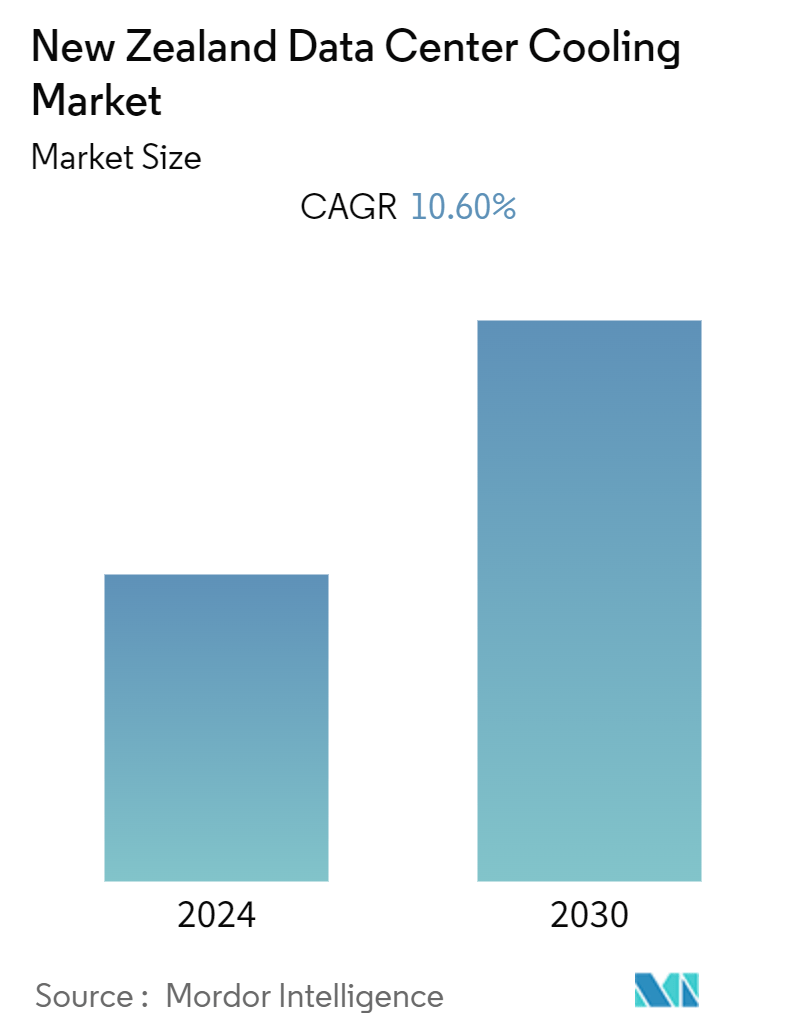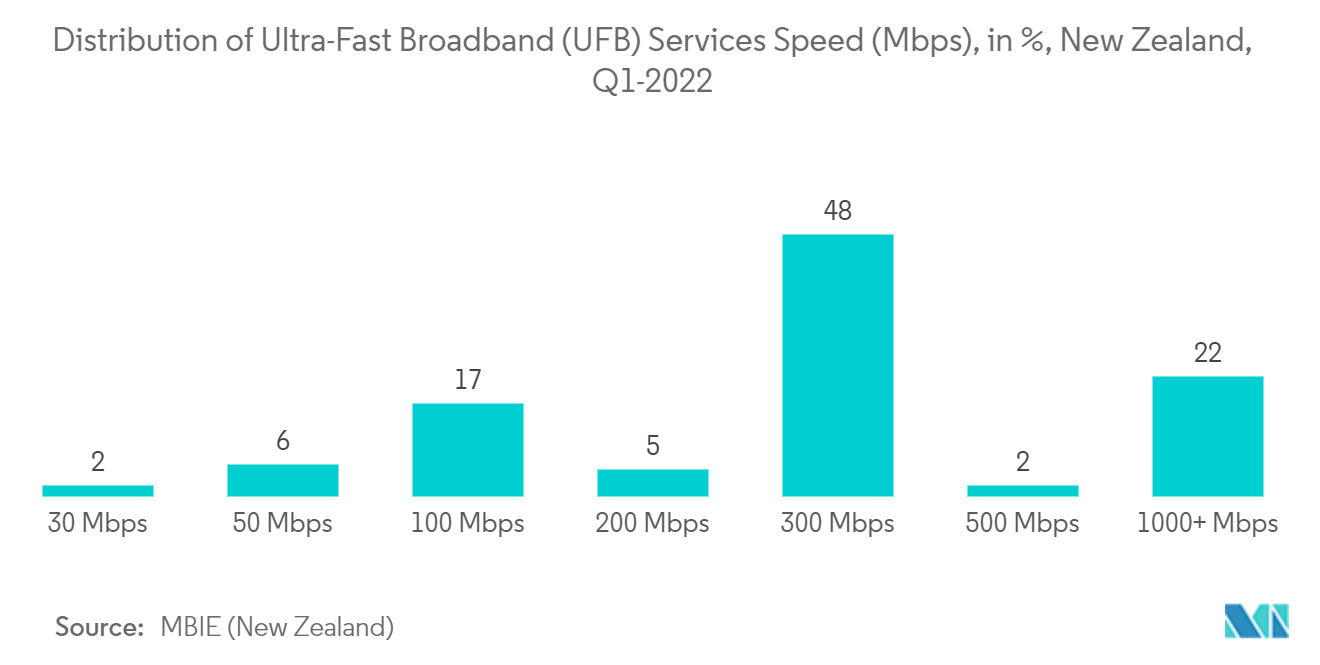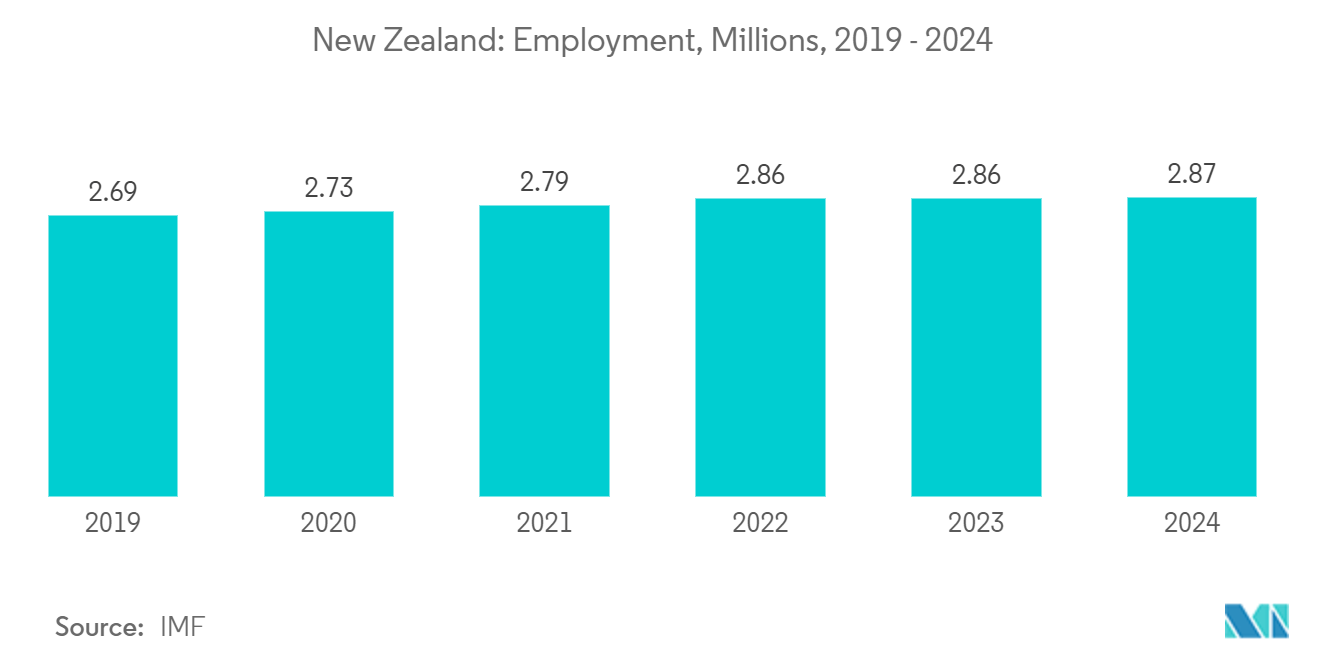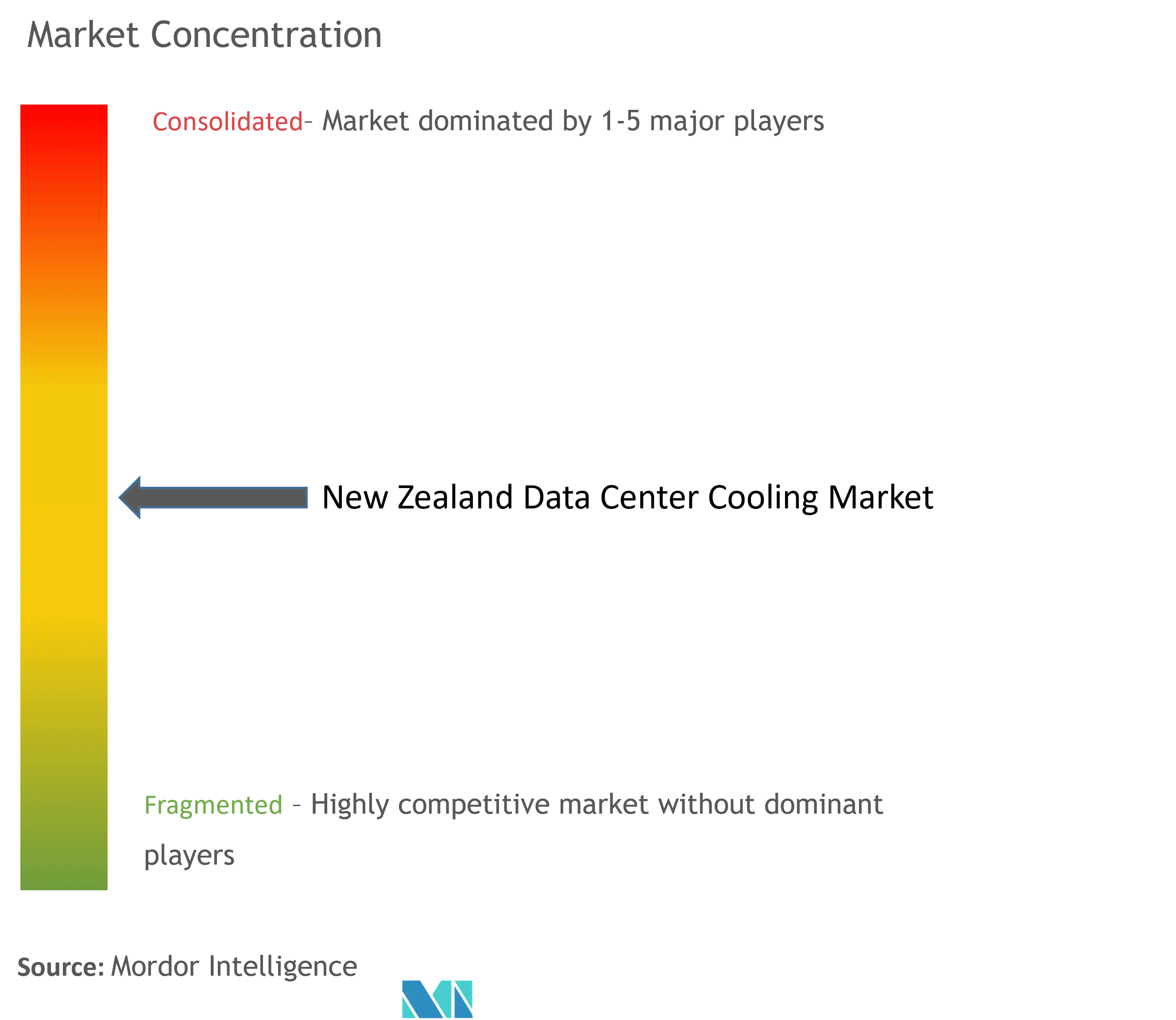New Zealand Data Center Cooling Market Size

| Study Period | 2019 - 2030 |
| Base Year For Estimation | 2023 |
| Forecast Data Period | 2024 - 2030 |
| Historical Data Period | 2019 - 2022 |
| CAGR (2024 - 2030) | 10.60 % |
| Market Concentration | Medium |
Major Players
*Disclaimer: Major Players sorted in no particular order |
New Zealand Data Center Cooling Market Analysis
The New Zealand Data Center Cooling Market is expected to register a CAGR of 10.60% during the forecast period.
The New Zealand data center rack market reached a value of USD 40.1 million in the previous year, and it is further projected to register a CAGR of 10.6% during the forecast period.
- The increasing demand for cloud computing among SMEs, government regulations for local data security, and growing investment by domestic players are some of the major factors driving the demand for data centers in the country/region.
- The upcoming IT load capacity of the New Zealand data center market is expected to reach 350 MW by 2029. The country's construction of raised floor area is expected to increase to 800K sq. ft by 2029.
- The country's total number of racks to be installed is expected to reach 35K units by 2029. Auckland is expected to house the maximum number of racks by 2029. New Zealand's average annual temperatures range from 10°C in the south to 16°C in the north.
- There are close to 8 submarine cable systems connecting New Zealand, and many are under construction. One such submarine cable that is estimated to start service in 2025 is Hawaiki Nui, which stretches over 25,000 Kilometers with landing points from Christchurch, New Zealand; Dunedin, New Zealand; and Invercargill, New Zealand.
New Zealand Data Center Cooling Market Trends
Liquid-based Cooling is the Fastest Growing Segment
- Technological advances have made liquid cooling easier to maintain, more scalable, and more affordable, reducing data center liquid consumption by more than 15% in tropical climates and by 80% in greener areas. The energy used for liquid cooling can be recycled to heat buildings and water, and advanced artificial refrigerants can effectively reduce the carbon footprint of air conditioners.
- Liquid cooling takes advantage of the superior heat transfer properties of water or other liquids to support efficient and cost-effective cooling of high-density racks, up to 3000 times more effective than using air. Long proven in mainframe and gaming applications, liquid cooling is increasingly being used to protect rack servers in data centers across the region.
- Direct liquid cooling solutions consistently achieve partial power usage effectiveness (PUE) values ranging from 1.02 to 1.03, surpassing even the most efficient air cooling systems by modest single-digit percentages. It's worth noting, however, that while DLC contributes significantly to energy efficiency, PUE doesn't capture the entirety of its energy-saving benefits. This is because traditional servers equipped with fans draw power from the rack, and their control mechanisms are factored into the IT power consumption section of the PUE calculation, classifying them as integral components of the data center payload.
- Water cooling can be essential in minimizing emissions and reducing climate disturbance. Data centers using water as a cooling substance use about 10% less energy than most air-cooled data centers, emitting about 10% less CO2.
- In 2022, in the Speedtest global ranking, New Zealand ranked eighth in the OECD countries for the percentage of fiber connections to total fixed connections and 18th in fixed-line broadband speed. Furthermore, the New Zealand government aims to have 100% fiber take-up by 2032 through its second phase of the national scheme. Under the initial phase, which ended in 2022, 87% of the population had direct access to fiber connectivity. The implementation of such broadband development plans would greatly improve service quality and network availability for all clients, which will stimulate internet services in the country and accelerate the expansion of data centers.

IT & Telecommunication is the Largest Segment
- ICT is key to the New Zealand government's strategy to foster innovation and local production. Collaboration between banks, the ICT industry, and the New Zealand government has created an atmosphere of community and information sharing.
- New Zealand is easing border restrictions on ICT professionals in a bid to attract the largest digital talent pool from around the world to the island nation. At the forefront of these border exclusions is NZTech, a government-funded marketing organization set up to promote New Zealand technology to global markets. As the company's CEO acknowledged, as New Zealand's digital economy grows, the country needs tech workers. In addition, the country is likely to see even greater demand for skilled workers in the technology industry.
- The market witnessed increasing investments from large corporations. The hyperscale operator Microsoft, announced the opening of cloud regions in 2022. AWS announced the AWS Asia-Pacific (Auckland) Cloud Region, which is expected to go live in 2024.
- New Zealand's technology industry contributes significantly to the country's GDP, exports, and employment. Despite labor shortages and a lack of local knowledge, job growth in New Zealand's digital sector is accelerating. Total global employment increased by 10.9% to 62,718, mainly due to increased employment in the ICT sector. The increase in high-paying IT jobs in the country has had a significant impact on the national economy.
- Recent economic analysis has shown the US to play a key role as an export market, which may indicate New Zealand's strong digital economy. This export includes both software licenses and computer services. The United States is New Zealand's third largest trading partner overall and is currently the country's top destination for services exports, accounting for more than 22% of all services exports, according to the country's secretary for trade and export growth.

New Zealand Data Center Cooling Industry Overview
The New Zealand Data Center Cooling Market is moderately competitive but has gained a notable competitive advantage in recent years. Currently, a handful of major players, including Stulz GmbH, Schneider Electric SE, Vertiv Group Corp., Rittal GmbH & Co. KG, and Mitsubishi Electric Hydronics & IT Cooling Systems SpA, hold a significant market share.
In March 2023, STULZ, a Hamburg-based company specializing in mission-critical air conditioning solutions, announced a significant milestone within its industry-leading CyberAir 3PRO DX series. Certain units within this series are now equipped to utilize the low-global warming potential refrigerant R513A. This groundbreaking development underscores the company's unwavering commitment to delivering the most environmentally sustainable air conditioning systems for data centers. Furthermore, STULZ has expanded the use of the R513A refrigerant across its product portfolio, reinforcing its dedication to eco-friendly cooling solutions.
New Zealand Data Center Cooling Market Leaders
-
Stulz GmbH
-
Schneider Electric SE
-
Vertiv Group Corp.
-
Rittal GmbH & Co. KG
-
Mitsubishi Electric Hydronics & IT Cooling Systems SpA
*Disclaimer: Major Players sorted in no particular order

New Zealand Data Center Cooling Market News
- March 2023: In a significant move, Managed Service Provider Interactive unveiled its Immersion Data Center Cooling solution with the primary goal of enhancing high-performance computing (HPC) capabilities for its valued clientele. Collaborating closely with digital infrastructure provider Vertiv, Interactive integrated cutting-edge Green Revolution cooling tanks into their system. This innovative approach employs a single-phase, non-conductive coolant that guarantees the safety of electrical components and boasts an impressive heat transfer capacity, surpassing that of traditional air cooling by 1200 times.
- March 2023: LiquidStack, a prominent player in the field, recently secured a strategic investment from HVAC industry leader Trane Technologies to push the boundaries of immersion cooling technology. LiquidStack's exclusive liquid immersion cooling system represents a leap forward in sustainable data center cooling practices. This advancement aligns seamlessly with the company's ambitious sustainability objectives, including a commitment to reduce carbon emissions within its customer footprint by a staggering 1 billion tons before 2030 and achieving complete net-zero emissions by 2050. LiquidStack's immersion cooling solutions also provide substantial benefits to its clients.
New Zealand Data Center Cooling Market Report - Table of Contents
1. INTRODUCTION
- 1.1 Study Assumption & Market Definition
- 1.2 Scope of the Study
2. Research Methodology
3. Executive Summary
4. Market Dynamics
- 4.1 Market Overview
-
4.2 Market Drivers
- 4.2.1 Development of IT Infrastructure in the Region
- 4.2.2 Emergence of Green Data Centers
-
4.3 Market Restraints
- 4.3.1 Costs, Adaptability Requirements, and Power Outages
- 4.4 Value Chain / Supply Chain Analysis
-
4.5 Industry Attractiveness - Porter's Five Forces Analysis
- 4.5.1 Threat of New Entrants
- 4.5.2 Bargaining Power of Buyers/Consumers
- 4.5.3 Bargaining Power of Suppliers
- 4.5.4 Threat of Substitute Products
- 4.5.5 Intensity of Competitive Rivalry
- 4.6 Assessment of COVID-19 Impact
5. MARKET SEGMENTATION
-
5.1 Cooling Technology
- 5.1.1 Air-based Cooling
- 5.1.2 Liquid-based Cooling
- 5.1.3 Evaporative Cooling
-
5.2 End-User
- 5.2.1 IT & Telecommunication
- 5.2.2 BFSI
- 5.2.3 Government
- 5.2.4 Media & Entertainment
- 5.2.5 Other End-Users
6. COMPETITIVE LANDSCAPE
-
6.1 Company Profiles
- 6.1.1 Stulz GmbH
- 6.1.2 Schneider Electric SE
- 6.1.3 Vertiv Group Corp.
- 6.1.4 Mitsubishi Electric Hydronics & IT Cooling Systems S.p.A.
- 6.1.5 Johnson Controls International PLC
- 6.1.6 Emerson Electric Co.
- 6.1.7 Fujitsu General Limited
- 6.1.8 Hitachi Ltd.
- 6.1.9 Danfoss A/S
- 6.1.10 Munters Pty Limited
- 6.1.11 Alfa Laval Corporate AB
- 6.1.12 Delta Electronics Inc.
- *List Not Exhaustive
7. INVESTMENT ANALYSIS
8. MARKET OPPORTUNITIES AND FUTURE TRENDS
** Subject To AvailablityNew Zealand Data Center Cooling Industry Segmentation
Data center cooling is a set of techniques and technologies to maintain optimal operating temperatures in data center environments. Data center cooling is critical as data center facilities house many computer servers and network equipment that generate heat during operation. Efficient cooling systems are used to dissipate this heat and prevent equipment from overheating, ensuring continued reliable operation of the data center. Various methods, such as air conditioning, liquid cooling, and hot/cold aisle containment, are commonly used to control temperature and humidity in data centers.
The New Zealand data center cooling market is segmented by cooling technology type (air-based cooling, liquid-based cooling, and evaporative cooling) and by end-user (IT & telecommunication, BFSI, government, media & entertainment, and other end-users).
The market sizes and forecasts are provided in terms of value (USD) for all the above segments.
| Cooling Technology | Air-based Cooling |
| Liquid-based Cooling | |
| Evaporative Cooling | |
| End-User | IT & Telecommunication |
| BFSI | |
| Government | |
| Media & Entertainment | |
| Other End-Users |
New Zealand Data Center Cooling Market Research Faqs
What is the current New Zealand Data Center Cooling Market size?
The New Zealand Data Center Cooling Market is projected to register a CAGR of 10.60% during the forecast period (2024-2030)
Who are the key players in New Zealand Data Center Cooling Market?
Stulz GmbH, Schneider Electric SE, Vertiv Group Corp., Rittal GmbH & Co. KG and Mitsubishi Electric Hydronics & IT Cooling Systems SpA are the major companies operating in the New Zealand Data Center Cooling Market.
What years does this New Zealand Data Center Cooling Market cover?
The report covers the New Zealand Data Center Cooling Market historical market size for years: 2019, 2020, 2021, 2022 and 2023. The report also forecasts the New Zealand Data Center Cooling Market size for years: 2024, 2025, 2026, 2027, 2028, 2029 and 2030.
New Zealand Data Center Cooling Industry Report
Statistics for the 2024 New Zealand Data Center Cooling market share, size and revenue growth rate, created by Mordor Intelligence™ Industry Reports. New Zealand Data Center Cooling analysis includes a market forecast outlook to for 2024 to 2030 and historical overview. Get a sample of this industry analysis as a free report PDF download.



